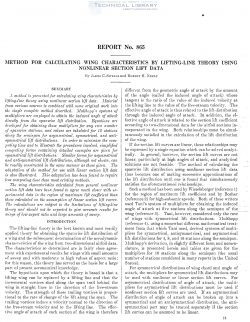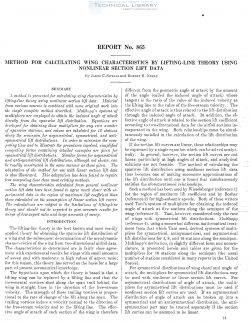naca-report-865

- Version
- 242 Downloads
- 1.75 MB File Size
- 1 File Count
- August 31, 2016 Create Date
- August 31, 2016 Last Updated
National Advisory Committee for Aeronautics, Report - Method for Calculating Wing Characteristics by Lifting Line Theory Using Nonlinear Section Lift Data

The method is presented for calculating wing characteristics by
lifting-line theory using nonlinear section lift data. lfaterial
from various sources is combined with some original worlc into
the single complete method described. JIulthopp‘s systems of
multipliers are employed to obtain the induced angle of attach
directly from the span-wise lift distribution. Equations are
developed for obtaining these multipliers for any even number
of spanurise stations, and values are tabulated for 10 stations
along the semispan for asymmetricah symmetrical, and anti—
symmetrical lift distributions. In order to minimize the com—
puting time and to illustrate the procedures involved, simplified
Computing forms containing detailed examples are given for
symmetrical lift distributions. Similarformsfor asymmetrical
and antisymmetrical lifi distributions, although not shown, can
be readily constructed in the same manner as those given. The
adaptation of the method for use with linear section lift data
is also illustrated. This adaptation has been found to require
less computing time than most existing methods.
The wing characteristics calculated from general nonlinear
section lift data have been found to agree much closer with ex-
perimental data in the region of maximum lift coefficient than
those calculated on the assumption of linear section lift curves.
The calculations are subject to the limitations of lifting-line
theory and should not be expected to give accurate results for
wings of low aspect ratio and large amounts of sweep.
The lifting—line theory is the best known and most. readily
upplicd theory for obtaining the spuuwise lift distribution of
a Wing and the subsequent determination of the aerodynamic
chzu'uctoristics of the Wing from two—dimensional airfoil data.
The characteristics so determined are in fairly close agree-
ment with experimental results for Wings with small amounts
of sweep and with moderate to high values of aspect ratio;
for this reason, this theory has served as the basis for a large
part of present aeronautical knowledge.
| File | Action |
|---|---|
| naca-report-865 Method for Calculating Wing Characteristics by Lifting Line Theory Using Nonlinear Section Lift Data.pdf | Download |

Comment On This Post